Submersible Bearings for Marine Use: Essential Guide for Optimal Performance
Introduction
Submersible bearings for marine use play a critical role in ensuring the smooth operation of underwater equipment. Designed to withstand extreme pressures, corrosive saltwater, and continuous submersion, these specialized components are vital for offshore drilling systems, submarine vehicles, and marine propulsion units. This comprehensive guide explores the technical specifications, applications, and maintenance strategies that make submersible bearings indispensable in marine engineering.
What Are Submersible Bearings?
Submersible bearings for marine use are precision-engineered rotational components specifically designed for prolonged underwater operation. Unlike standard bearings, they feature advanced sealing mechanisms and materials like stainless steel AISI 316 or super duplex alloys to resist biofouling and saltwater corrosion. Their multi-layered protection system prevents water ingress while maintaining lubrication efficiency under high axial loads.
Key Advantages of Marine-Grade Bearings
Modern submersible bearings for marine applications offer 30% greater load capacity than conventional models. Their hydrodynamic seals extend service life by 40% in abrasive environments, while specialized polymer cages reduce friction losses by up to 25%. These enhancements directly translate to reduced maintenance costs and improved operational reliability for tidal energy converters and deep-sea ROVs.
Industrial Applications
 From offshore wind turbine yaw systems to desalination plant pumps, submersible bearings for marine use enable critical operations. Recent case studies demonstrate their effectiveness in Arctic research vessels where they maintain functionality at -40°C, and in tropical marine dredgers combating accelerated biofouling rates.
From offshore wind turbine yaw systems to desalination plant pumps, submersible bearings for marine use enable critical operations. Recent case studies demonstrate their effectiveness in Arctic research vessels where they maintain functionality at -40°C, and in tropical marine dredgers combating accelerated biofouling rates.
Material Selection Guide
When choosing submersible bearings for marine equipment, consider operating depth and chemical exposure. Silicon nitride ceramic bearings excel in high-speed applications up to 6,000 RPM, while bronze-reinforced polymer variants prove ideal for shock-loaded wave energy converters. Our technical team recommends conducting tribological analysis for specific salinity levels and particulate concentrations.
Maintenance Best Practices
Implementing a predictive maintenance program for submersible bearings in marine environments can increase Mean Time Between Failures (MTBF) by 60%. Key strategies include quarterly ultrasonic thickness testing, automated lubrication monitoring, and seawater pH-adjusted greasing intervals. Proper storage in nitrogen-flushed containers prevents pre-installation corrosion.
FAQs
Q: How deep can marine submersible bearings operate?
A: Our premium-grade bearings are pressure-tested at 10,000 PSI, suitable for depths exceeding 3,000 meters.
Q: What certification standards apply?
A: All bearings meet DNVGL-OS-E-101 and ABS Guide for Bearing Applications requirements.
Why Choose Our Solutions
As ISO 9001-certified manufacturers of submersible bearings for marine use, we combine aerospace-grade materials with hydrodynamic engineering. Our bearings feature patented VortexShield™ sealing technology proven to outperform standard designs in independent maritime trials.
Conclusion
Selecting the right submersible bearings for marine applications directly impacts operational efficiency and safety. Contact our engineering team today for customized solutions matching your specific marine environment requirements.




 13869596835
13869596835